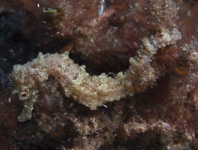Abstract
The species Lygosoma (Keneuxia) dubium was described by Franz Werner (1909) based on a single specimen from the Royal Natural History Cabinet (Königliches Naturalienkabinett) in Stuttgart, collection number 3651. According to the original description the specimen was collected by “Direktor Mayer” in Yokohama, Japan in 1897. Much later Nakamura & Ueno (1963) transferred the species to the Genus Dasia Gray, 1839, without further comments. Recently Uetz et al. (2018) questioned the type locality given by Werner (1909) and suggested that the name Lygosoma dubium is likely to be a synonym of Dasia grisea (Gray, 1845) referring to a personal comment of T. Hikida in 2014. However the actual taxonomic status of the species still remains unresolved.
References
Biswas, S. & Sanyal, D.P. (1977) A new species of skink of the genus Dasia Gray, 1889 from Car Nicobar Island, India. The Journal of the Bombay Natural History Society, 74, 133–136.
Brown, W.C. & Alcala, A.C. (1980) Philippine lizards of the family Scincidae. Silliman University for Natural Science, Dumaguete City, 246 pp.
Das, I. (2004) Lizards of Borneo. Natural History Publications, Kota Kinabalu, Borneo, 83 pp.
Das, I. (2010) A Field Guide to the Reptiles of South-East Asia. New Holland Publishers, London, 376 pp.
Geissler, P., Duc, M.H. & Nguyen, Q.T. (2011) First record of Dasia olivacea Gray, 1839 (Squamata: Scincidae) from the mainland of Vietnam. Herpetology Notes, 4, 261–262.
Goris, R.C. & Maeda, N. (2004) Guide to the amphibians and reptiles of Japan. Krieger Publishing Company, Malabar, Florida, 285 pp.
Gray, J.E. (1845) Catalogue of the specimens of lizards in the collection of the British Museum. Trustees of die British Museum/Edward Newman, London, 289 pp.
Greer, A.E. (1970) The relationships of the skinks referred to the genus Dasia. Breviora, 348, 1–30.
Grismer, L.L. (2011) Lizards of Peninsular Malaysia, Singapore and their adjacent archipelagos. Edition Chimaira, Frankfurt, 728 pp.
Harikrishnan, S., Vasudevan, K., De Silva, A., Deepak, V., Kar, N.B., Naniwadekar, R., Lalremruata, A, Prasoona, K.R. & Aggarwal, R.K. (2012) Phylogeography of Dasia Gray, 1830 (Reptilia: Scincidae), with the description of a new species from southern India. Zootaxa, 3233, 37–51.
Hikida, T. (2003) Biogeography of reptiles in islands in East Asia: geographic distributions from views of molecular and morphological studies. Biological Science, 54, 205–220.
Inger, R.F. & Brown, W.C. (1980) Species of the scincid genus Dasia Gray. Fieldiana Zoology, 3, 1–11.
Nakamura, K. & Ueno, S. (1963) Japanese amphibians and reptiles in colour. Hoiku-sha, Osaka, 214 pp. [in Japanese]
Okamoto, T. (2017) Historical biogeography of the terrestrial reptiles of Japan: A comparative analysis of geographic ranges and molecular phylogenies. In: Motokawa, M. & Kajihara, H. (Eds.), Species diversity of animals in Japan. Springer Japan, Tokyo, pp. 135–163.
https://doi.org/10.1007/978-4-431-56432-4_5
Schlüter, A. (2001) Die herpetologische Sammlung des Staatlichen Museums für Naturkunde Stuttgart. In: Rieck, W., Hallmann, G. & Bischoff, W. (Eds.), Die Geschichte der Herpetologie und Terrarienkunde im deutschsprachigen Raum. Wahrlich Druck, Rheinbach, pp. 396–399.
Schlüter, A. & Hallermann, J. (1997) The type specimens in the herpetological collection of the Staatliches Museum für Naturkunde Stuttgart. Stuttgarter Beiträge zur Naturkunde, Serie A, 553, 1–15.
Taylor, E.H. (1922) The lizards of the Philippine Islands. Department of Agriculture and Natural Resources, Bureau of Science, Government of the Philippine Islands, Manila, 269 pp.
Uetz, P., Freed, P. & Hošek, J. (2018) The Reptile Database. Available from http://www.reptile-database.org/ (accessed 4 May 2018)
Vassilieva, A.B., Galoyan, E.A., Poyarkov, N.A. & Geissler, P. (2016) A photographic field guide to the amphibians and reptiles of the lowland monsoon forests of southern Vietnam. Edition Chimaira, Frankfurt, 324 pp.
Werner, F. (1909) Beschreibung neuer Reptilien aus dem Kgl. Naturalienkabinett in Stuttgart. Jahreshefte des Vereins für Vaterländische Naturkunde Württemberg, 65, 55–63.
Wickramasinghe, L.J.M., Wickramasinghe, N. & Kariyawasam, L. (2011) Taxonomic status of the arboreal skink lizard Dasia halianus (Haly & Nevill, 1887) in Sri Lanka and the redescription of Dasia subcaeruleum (Boulenger, 1891) from India. Journal of Threatened Taxa, 3, 1961–1974.
https://doi.org/10.11609/JoTT.o2300.1961-74

